OHV engine design
OHC or SOHC engine
OHC means OverHead Cam in general, while SOHC means Single OverHead Cam or Single Cam.
In a SOHC engine the camshaft is installed in the cylinder head and valves are operated either by the rocker arms or directly through the lifters (as in the picture). The main advantage of an OHC design is that valves are operated almost directly by the camshaft, which makes it easier to maintain precise timing at higher RPMs. It's also possible to install three or four valves per cylinder. For example, Honda successfully uses the SOHC design in its late V6 engines where 4 valves per cylinder are operated by a single camshaft. See the Acura TL 3.2L 24-valve SOHC V6 engine in the second photo (Acura is Honda's luxury vehicle division). The main disadvantage of an OHC or SOHC engine is that it requires a timing belt or chain with related components, such as tensioners and guides to run the camshaft(s). This means higher production cost and more complex design. A timing belt needs to be replaced at regular intervals, typically every 60,000-120,000 miles, which adds to maintenance costs. A timing chain can last longer, but it is sensitive to regular maintenance: if engine oil is not changed regularly, a timing chain stretches and wears out. |
DOHC or Twin Cam engine
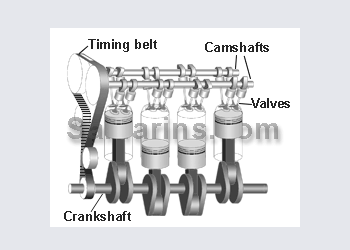
4-cylinder 16-valve DOHC engine
|
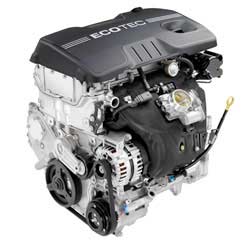
GM 2.4L direct-injection DOHC Ecotec. Photo:GM
|
DOHC means Double OverHead Cam, or sometimes it could be called "Twin Cam" or "Double Cam." Most modern cars have DOHC engines.
A typical DOHC engine has two camshafts and 4 valves per cylinder. One camshaft operates intake valves that are installed on one side, while another camshaft controls exhaust valves on the opposite side. With this design, camshafts can be installed further apart from each other. This allows the intake valves to be at a larger angle from the exhaust valves, which results in a more direct air flow through the engine with less obstruction. In other words, a DOHC engine can "breathe" better and thus produces more horsepower out of smaller engine volume. Compare: The 3.5-liter V6 DOHC engine of the 2003 Nissan Pathfinder has 240 hp, similar to 245 hp of the 5.9-liter V8 OHV engine of the 2003 Dodge Durango.
Technologies like Direct Injection, Variable Valve Timing and Variable Valve Lift can be easily implemented in a DOHC engine, further improving fuel efficiency. For example, the 2013 Chevrolet Equinox SUV with a 2.4L 4-cylinder direct-injection Ecotec engine (in the photo) is rated at 32 mpg on the highway; something that not every family sedan can beat.
Downsides of the DOHC technology include a more complex design with additional timing belt or chain components. A timing belt needs to be replaced at recommended intervals, adding to maintenance costs.
A typical DOHC engine has two camshafts and 4 valves per cylinder. One camshaft operates intake valves that are installed on one side, while another camshaft controls exhaust valves on the opposite side. With this design, camshafts can be installed further apart from each other. This allows the intake valves to be at a larger angle from the exhaust valves, which results in a more direct air flow through the engine with less obstruction. In other words, a DOHC engine can "breathe" better and thus produces more horsepower out of smaller engine volume. Compare: The 3.5-liter V6 DOHC engine of the 2003 Nissan Pathfinder has 240 hp, similar to 245 hp of the 5.9-liter V8 OHV engine of the 2003 Dodge Durango.
Technologies like Direct Injection, Variable Valve Timing and Variable Valve Lift can be easily implemented in a DOHC engine, further improving fuel efficiency. For example, the 2013 Chevrolet Equinox SUV with a 2.4L 4-cylinder direct-injection Ecotec engine (in the photo) is rated at 32 mpg on the highway; something that not every family sedan can beat.
Downsides of the DOHC technology include a more complex design with additional timing belt or chain components. A timing belt needs to be replaced at recommended intervals, adding to maintenance costs.
reference : http://www.samarins.com/glossary/dohc.html
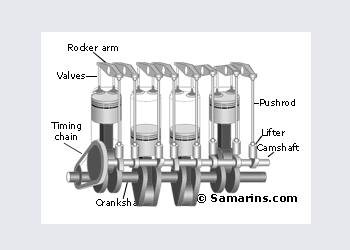
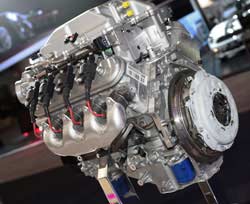
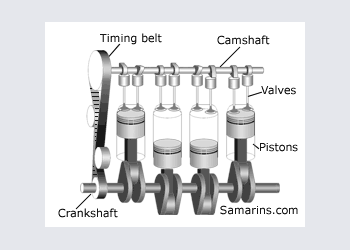
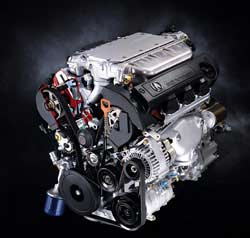
No comments:
Post a Comment